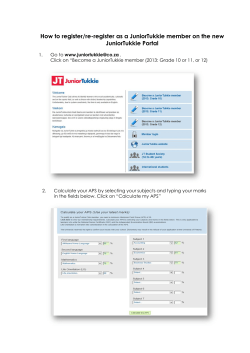
Beam Position Monitors: How to Meet the Specifications of Most-Recent Accelerators Glenn Decker
Beam Position Monitors: How to Meet the Specifications of Most-Recent Accelerators Glenn Decker Advanced Photon Source Diagnostics Group Leader September 18, 2013 Overview Beam stability requirements Pickup Electrodes / Sensors Electronics / Data Acquisition / Processing B(PM)^2 Glenn Decker APS, IBIC 2013 Beam Stability Performance Requirements Facility Stability Requirement (microns rms) Bandwidth Cornell ERL 0.3 1 kHz LCLS-II FEL < 1.0 60 Hz E-XFEL 3.0 > 1 kHz SwissFEL < 1.0 50 Hz APS upgrade 0.4 / 0.8 200 Hz / 1 kHz Glenn Decker APS, IBIC 2013 Beam Stability Performance Goals In Detail Requirements for the APS Upgrade are RMS Motion (0.1-200 Hz) Horizontal Vertical Glenn Decker APS, IBIC 2013 Long term (1 week, rms) Now 5.0 μm 0.85 μrad 7.0 μm 1.4 μrad Upgrade 3.0 μm 0.53 μrad 5.0 μm 1.0 μrad Now 1.6 μm 0.80 μrad 5.0 μm 2.5 μrad Upgrade 0.42 μm 0.22 μrad 1.0 μm 0.5 μrad BPM Pickup Electrodes at APS Insertion Device Source Points 4 mm-diameter buttons w/ 1-cm horz. separation, 7.5 mm vert. gap Glenn Decker APS, IBIC 2013 Other BPM Pickup Electrodes Cold E-XFEL Button Warm E-XFEL Button 4-mm button application, Rotated Geometry, 4 mm vertical aperture APS LEUTL Glenn Decker APS, IBIC 2013 Stripline Pickup Electrodes / Kickers* Strongly-couples to the beam Commonly used for broadband multibunch feedback systems Signal comes out of the upstream end when used as a pickup Power goes in at the downstream end when used as a kicker Typical length is a quarter wavelength of the central frequency of interest Glenn Decker APS, IBIC 2013 *Google Glen Lambertson stripline pickups kickers LCLS Cavity Beam Position Monitors X-Band copper cavity demonstrated < 500 nm single-shot resolution* Glenn Decker APS, IBIC 2013 *Stephen Smith et al., PAC’09 Shintake-Style Cavity Beam Position Monitors S-Band Steel Cavity developed for E-XFEL -Demonstrated < 200 nm single-shot resolution* Glenn Decker APS, IBIC 2013 *M. Stadler et al., IBIC’12 BPM Electronics Topologies Commercial In-house developed Hybrids Glenn Decker APS, IBIC 2013 BPM Electronics Topologies LCLS I-Tech Glenn Decker APS, IBIC 2013 ExFEL@SITF@PSI NSLS-II Commercial Solution Noise floor approaching 2 nm / √Hz. Insensitive to fill pattern Long term drift 200 nm p-p / 24 hours*. * Guenther Rehm, Diamond Light Source, EPAC 2008 Glenn Decker APS, IBIC 2013 APS Broadband RF BPM data acquisition (BSP-100) Eight channels/board, 88 MS/sec sampling. Altera FPGA processing. Used with AM/PM rf front end One second (262144 samples) turn-by-turn beam history for machine studies / fault diagnosis. Demonstrated noise floor < 6 nm / √Hz Glenn Decker APS, IBIC 2013 nm rms Storage Ring BPM Electronics Performance Plots show the square root of the forward-integrated power spectral density. Glenn Decker APS, IBIC 2013 14 LCLS Cavity BPM Electronics* μTCA Rear Transition Module 16-bit 119 MS/sec digitizer w/ FPGA processor (SIS) (RTM) Glenn Decker APS, IBIC 2013 *Courtesy A. Young, SLAC Field-Programmable Gate Arrays Xilinx ZC706 evaluation board. 4dsp 8-channel 16 bit 250 MS/sec FMC ADC Glenn Decker APS, IBIC 2013 Faster Technology FM-S18 8*SFP FMC MGT APS Fast Orbit Feedback FPGA System Architecture Glenn Decker APS, IBIC 2013 Courtesy R. Lipa, ANL Beam Arrival Time Jitter Power Spectral Density (APS) 60 Hz 360 Hz from Main RF στ = 2.1 ps = rms jitter, 0.3 Hz to 3 kHz στ(ω) = Square Root of reverseintegrated power spectral density Synchrotron Tune Note: the rms bunch length for 24-singlets fill pattern is 34 ps. Glenn Decker APS, IBIC 2013 18 Mechanical Motion Correlated with Temperature Vacuum chamber water temperature correlates with BPM position readback. BPM Instrumented with a Keyence Laser tracker to measure BPM movement relative to APS Air / WaterTemp. Temperature regulation is at the level of 0.3 – 0.5 deg. C p-p for air, and 0.06 deg. C p-p for water. (24 hours) Mechanical motion monitoring system proposed for APS Upgrade Glenn Decker APS, IBIC 2013C Correlation of measured beam position and water temperature 0.5 m / 0.06 deg.C 0 1 Time (hours) 2 ID Chamber BPM Pickup Electrode Courtesy Bob Lill ANL Impact of missed top-up shots Air Temp. (deg. F) Beam Current (mA) Position Sensor Readback Glenn Decker APS, IBIC 2013C 0.04 deg. F 2 mA (2%) 1 micron Capacitive Proximity Sensors Capacitive sensors provide a simple non-contact measurement Reactance of the capacitor, changes in direct proportion to the gap distance. NCDT 6300 single channel system 0.01 % FSO resolution in 8KHz BW Glenn Decker APS, IBIC 2013 Courtesy Bob Lill ANL Super Invar Simple Invar stand was designed to evaluate capacitive detection of BPM Super Invar was used because of its very low thermal expansion (270 nm/C) for full length of support Standard Invar can provide a significant cost saving if requirements relaxed. Glenn Decker APS, IBIC 2013C Hydrostatic Leveling System (HLS) Hardware Sensors have two main parts: reservoir and the electronics The face of the upper part is the capacitive pick up Reactance of the capacitor changes in direct proportion to the water level HLS is based on the communicating vessels principle Glenn Decker APS, IBIC 2013C Sensor design from Budker Institute, used at Fermilab LCLS Wire Position Monitor and HLS Glenn Decker APS, IBIC 2013C H.D. Nuhn etal.,, FEL’11 Proposed X-ray Beam Alignment System at APS* Button Pickups Direct detection of hard x-ray beam position (XBPMs) provides factor of 5 lever arm advantage. Intensity monitors (IM) monitor hard x-ray flux through critical apertures. Mechanical motion sensing network links rf BPMs, x-ray BPMs, and critical apertures, e.g the beamline exit mask (EM). Glenn Decker APS, IBIC 2013C * B.X. Yang, PAC’11 Block Diagram for Proposed APS Mechanical Motion Sensor System Glenn Decker APS, IBIC 2013C 26 Summary / Conclusions BPM System must be tailored to the application Ring-based light sources FELs Colliders Electronics are largely not the performance limitation FPGAs provide huge untapped potential BPM mechanical stability extremely difficult below 1 micron
© Copyright 2025










